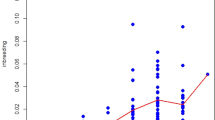Summary
-
1.
This paper has been stimulated by recent illuminating remarks by Lush about the inescapable limits to intensity of selection amongst females in farm livestock.
-
2.
Most white Wensleydale sheep, deep blue inside the ears, are heterozygous whites. Many animals pale inside the ears, but by no means all, are homozygous whites. The significance of ear colour in white Wensleydale sheep is discussed more fully than in earlier papers.
-
3
Monozygotic twinning, if it ever occurs, is very rare.
-
4.
Fertility is high in the Wensleydale breed. The average number of lambs per ewe put to the ram at Underley was 1·71. Of all the lambings 69 per cent, were multiple births.
-
5.
Fertility is higher at 4 and 5 years than at 2 and 3 years, this being partly due to decrease in barrenness and abortion.
-
6.
Within the Underley flock differences of inborn fertility were searched for in vain. It may well be that the whole breed stands at a high level of innate fertility.
-
7.
In Wensleydale crosses high fertility is transmitted by the Wensleydale rams to their cross-bred daughters.
-
8.
At Underley nearly 40 per cent. of all ewe lambs born were retained in the flock as breeding ewes.
-
9.
Ewes remained in the flock, on the average, for three seasons, and produced 5·11 lambs.
-
10.
The Wensleydale colour standard severely limits the intensity of selection for non-colour characters which can be practised amongst female breeding sheep.
Similar content being viewed by others
References
Dry (1924).J. Genet. 14.
Dry (1926).J. Text. Inst., Manchr,17.
Dry (1927). Ibid.18.
Heape (1899).Proc. roy. Soc. 65.
Jones andRouse (1920).J. Dairy Sci. 3.
Lush (1935).Empire J. exp. Agric. 3.
Nichols (1926).J. Minisi. Agric. 33.
Nichols (1926).J. agrie. Sci. 16.
Roberts, E. (1921).J. agric. Res.}22.
Wriedt (1924).Z. Tierzüchtung,1.
Author information
Authors and Affiliations
Rights and permissions
About this article
Cite this article
Dry, S.W. The genetics of the wensleydale breed of sheep. Journ. of Genetics 33, 123–134 (1936). https://doi.org/10.1007/BF03027606
Issue Date:
DOI: https://doi.org/10.1007/BF03027606




